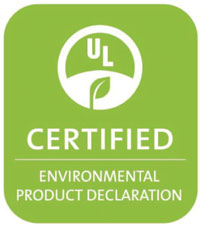Health and Transparency in Product Declarations
Impact Categories
While the information contained in EPDs is clearly useful and desirable, it should be recognized that it is limited to the specific environmental impacts assessed. These environmental impacts are typically organized into different categories to describe the specific impacts during a product’s life cycle (or individual phases) on specific areas of concern. The ISO standard requires that a minimum number of specific environmental impact categories must be measured and included in the LCA. Where applicable, PCRs further define which impact categories must be reported in each EPD. Of course, EPDs can always report more impact categories than required by the PCR. Environmental impact categories generally include, but are not limited to, such things as:
- Resource Depletion (Biotic/Abiotic) —the consumption of non-renewable resources including those used for energy (oil, gas, coal, metals, etc.)
- Acidification potential—the potential for the product to contribute to acid rain
- Eutrophication potential—the product’s contribution to water or soil nutrients that cause algal blooms
- Global Warming potential—emissions of carbon dioxide or methane that affect the earth’s atmosphere

An Environmental Product Declaration should be independently verified for accuracy and completeness.
Image courtesy of Forbo Flooring Systems
- Ozone Layer Depletion potential—the reduction in beneficial environmental ozone caused by chlorofluorocarbon emissions
- PhotochemicalOzone Creation potential—contributions to smog caused by hydrocarbon emissions
It is important to recognize that all of the parts of the process as discussed above are inherently tied together. Product category rules (PCRs) for a specific product type or category are developed following the guidelines authored by ISO. A life cycle assessment (LCA) is then performed by an independent entity for a specific product or material according to the PCR and the specific minimum impact categories that indicates must be measured and accounted for. The results of the LCA are then used to publish an environmental product declaration (EPD) that comes from the manufacturer. When architects, engineers, or others request this EPD, then, it is a representation that the proper process has been followed to produce it. It is the EPD that ultimately is used by the design team to assess different products and materials for sustainability and to provide documentation for green building certification programs.









